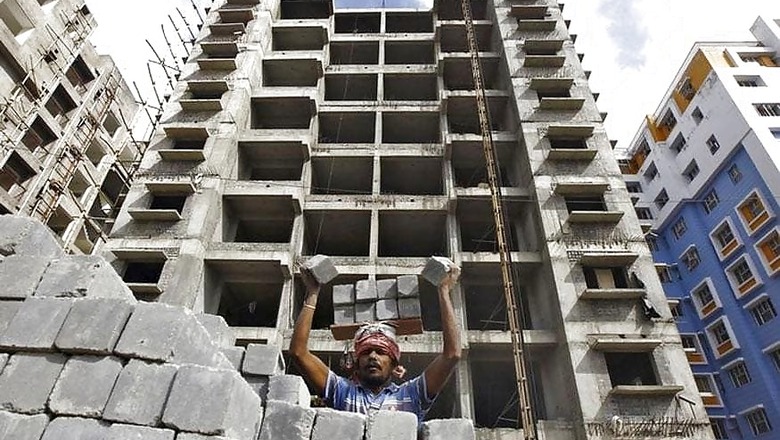
views
Real Estate investments are booming these days as people are either buying home for their. However, it's difficult for a layman to understand the nitty-gritty of the real estate business let alone understand the specific terminology used by the builders, brokers and other professionals from the real-estate industry.
Being unaware of Real-Estate terminology can catch a home-buyer on the wrong foot by being befooled by the builder. Here's a layman’s guide to decode the real estate jargons used by the industry experts that you need to know if you are planning to buy a home in the near future:
1. Carpet Area
When you intend to buy a flat, the first thing that you will hear is the carpet area i.e. in simple words the length and the breadth of the area that you'll be able to utilize on the floor. It is basically the area where you can lay the carpet hence the term ‘carpet area’. More the carpet area, more space you get. This is one parameter that you could rely on while looking for a property.
2. Built up area
Built up area is the entire carpet area plus the space covered by walls and doors. And since approximately 15-20% space is taken up by walls and doors alone thus the built up area is approximately 20% more than the carpet area. Usually the rate that the builders quote is as per the “built up area”.
3. Super Built up Area
Many times you must have seen that builders advertise their projects using the term “super built up area” which is nothing but a means to mislead you. Super built up area is built up area which has already covered the space that goes into walls and doors along with the common space that all the residents of the society share for example -corridors, parking area, etc. This is one figure that is not exclusive to your property but includes a lot of common space as well and thus shouldn’t be relied upon.
4. Title Deed
This is the legal document that is used to prove the ownership of a particular person over a certain property. When you are buying property from a person, make sure that you check the title deed and that the title deed is in the name of the owner or even better in the name of the person you’re dealing with. Don’t fall for excuses because it might get nasty later on, when you find out that the property you bought from Mr. A belongs to Mr. B. Another thing to keep in mind is that do not rely solely on photocopies of a title deed and always get it verified with the original deed, as photocopies can be easily forged or in case where the seller doesn’t tell you about a loan on the property, you can find out for yourself. Title deeds can easily be obtained from the Registry office of the area under whose jurisdiction the property falls. You can also engage a lawyer for the same.
Most often what happens is that the person who is trying to sell you the property is not the real owner of the land and thus the title deed isn’t in his name. In his defense the usual excuse that such people give is that the owner is abroad but I have the Power of Attorney. PoA is the legal way by which a person can engage another person (attorney) to act, conduct and manage the affairs of the person making the PoA. However, Supreme court has banned any and all real estate transactions based on power of attorney. Thus, always try to deal with the person who has a clear title deed, in his name.
5. Encumbrance Certificate
It is a legal document that shows that the property is free of any legal or monitory dues, mortgages, etc. So, in case you plan to take a bank loan on some property you will have to get an Encumbrance certificate from the Sub-Registrar office so that the Bank can be sure that no other loan has been taken on the same property.
6. Sub-Registrar Office
The Government office where the registrations of Properties take place is called a “sub registrar office”. All the work regarding registration of properties, obtaining legal documents related to properties or land, is done here. It’s easy to find anything on Google nowadays so you can even find the address of the sub registrar office for your location easily, online.
7. Stamp Duty and Registration Charges
These are mandatory charges. Stamp duty is the tax collected by the Govt. on real Estate properties. This stamp duty that is to be paid is different for every state, some states charge 3-4% whereas some charge 8% and also some states have a different rate for women and different for men like Delhi has 4% stamp duty for women whereas 6% for men. The stamp duty is charged or calculated on the agreement value so to evade paying a higher stamp duty, the buyer and seller mention a lesser amount on the agreement and pay the omitted amount in “black”. Stamp duty for a property that costs ₹50 Lakhs may be somewhere around ₹2-3 Lakhs, thus while finalizing your budget for real estate property consider the cost of stamp duty as well.
Registration charges on the other hand are comparatively less than stamp duty. These charges are paid at the time of getting the property registered in your name. Charges again differ from state to state eg: Maharashtra has registration charges at 1% of property or ₹30,000/- whichever is lower.
8. Franking Charges
These are the charges that are paid by the buyer to the bank if he obtains a loan from the bank. The requisite documents need to be stamped by an official seal of the Sub-Registrar’s Office just to prove the fact that the Govt. has received the stamp duty from you. It is done at a nominal fees (few hundred), the bank gets it done and charges the buyer for that.
9. Sale Deed
Is the most essential legal document in the sale and purchase of property and contains all the details regarding the property like title, history, description, boundaries, price, etc. The sale of a property is not legal unless the sale deed is signed by both the buyer and purchaser along with 2 witnesses. The registration charges along with stamp duty are chargeable on the amount of the property as quoted in the sale deed.
10. Conveyance Deed
Once all the flats in a project are sold, the conveyance deed is executed by the builder in favor of the housing societies formed transferring his rights in the land to the housing societies. If this legal document in not executed in favor of the societies and remains with the builder, there might be a feud later on which will result in unnecessary legal battles.
11. Ready Reckoner Rates or Guidelines Value
The Govt. has specified official rates for properties in each area also called the “circle rate”. This circle rate acts as the base price for the property and the minimum stamp duty charges and registration charges are paid on that minimum base price. Usually, a premium is charged by builders over these guideline values.
12. FSI (Floor Space Index)
The Municipal Corporation or the Urban Development Authority of an area specifies the extent of the area that can be built over a specific piece of property. Eg. If the MC has specified FSI for an area as 2 then, on a 1000 sq. ft. plot then only 2 x 1000= 2000sq ft. construction can be done over that 1000 sq.ft. land. Usually, common areas like staircases, lifts, etc. are excluded from this FSI which implies that these areas can be built beyond the specified FSI area.


















Comments
0 comment